Marketing Strategies
Artificial intelligence (AI) in marketing
30-second summary:
- Artificial intelligence (AI) is revolutionizing DCO (Dynamic Creative Optimization) and CDP analytics by giving these programs access to multiple data points, across business silos, a more accurate customer profile and effective campaigns.
- Personalized AI marketing can drive growth and creates better engagement with your audience
- AI is here to stay, but not in the way consumers think, it will not replace humans
- The COVID-19 pandemic emphasized to most marketers and brands the importance of being able to quickly change content and messages across all communication channels.
Artificial Intelligence (AI) is taking the world by storm. It is a relevant game-changer for every vertical, from legal to retail to travel to ecommerce and the list goes on. It only grows more in impacting almost every facet of our daily lives.
So, what is AI? And as a marketer, what can it do for you?
It is important to understand that AI is not a solution. It is not a piece of technology that you license, and that stands alone.
It is a compilation of several technology solutions that evolve on their own, but when combined – the fused solution (“The Machine”) can observe, evaluate, understand, act, analyze, learn and improve at a very high speed, scale and efficiency that go beyond any human capabilities.
One of the biggest misconceptions is that AI will replace humans. It will not. Rather, it will allow them to focus on what only humans can and should focus on, such as strategy, concepting and the storytelling.
The machine helps with automating production speed and scale, and the heavy lifting of processing massive amounts of data, analyzing and identifying insights – actions that will take humans weeks to fulfill while the machine is able to handle in milliseconds.
When it comes to marketing, we can divide AI to three main aspects that can help us better measure and understand how, when and to what extent to utilize AI and the value it can provide: Automation, Decisioning, Optimization.
AI and Automation
‘Automation’ is increasingly becoming more relevant as channels, formats and experiences are added to the marketing mix and the number of touchpoints between a brand and its consumers are constantly increasing.
Marketers need to be able to produce, control and test the content and the quality of the experiences delivered to each individual. We are already beyond the scale that humans can handle, and things only get more and more complex.
AI allows us to streamline the production of ad experiences and messaging at high scale, quickly and cost-efficiently, using dynamic creative templates and massive feeds that include all the potential combinations of products, messages, locations, call-to-actions, backgrounds, content, and more, where literally every component in the ad experience is fully dynamic and can be customized and personalized per viewer in real time.
Recent events resulting from the COVID-19 pandemic only emphasized to most marketers and brands the importance of being able to quickly change content and messages across all communication channels and to stay relevant and authentic.
Decisioning with AI
‘Decisioning’ is where data is introduced into the mix. How do you make sure that every element and component within the experience you serve your consumers is the most relevant for them and resonates with them?
How do you make sure it relates to their own personal context, location and time – three important factors that can build brand trust or crush it instantly if not done and executed correctly.
AI plays a huge role here in the real time decision making of what to show to who, when and why.
Decisioning is also where different situational data signals beyond user preferences, behavior and affinity come into the mix, such as time of day, weather conditions, location, language, and other parameters that should affect the experience delivered.
Advanced marketing teams are investing time and bandwidth on the strategic level and utilizing AI for the more tactical execution.
Up until now we dealt with the activation part. Now we get to the more interesting and sophisticated part where AI truly accel, as it simply becomes impossible for humans to handle.
Optimization with AI
‘Optimization’ is where scale and speed matter the most.
Just think, not that long ago the first machine-based optimization was just simple A/B testing for better click rates, then media performance was added to click rates and that made for more effective spending, but you were still measuring only two variables… but now, there are dozens of variables and more complex decisions, can we handle it the same way, at the same speed we used to for a single or two variants?
Well, as a marketer you already know the answer.
The current amount of data from every captured event and user interaction collected from all experiences served, in all ad formats across all channels for every user in every online impression, email, in-store activation and other environments, are all aggregated, analyzed and digested into meaningful, actionable learnings.
But the role of true AI doesn’t end here. Your platform should learn as it goes, and — most importantly — use what it learns in each channel to make decisions in the others. For most companies, what they learn in YouTube only applies to optimizing in YouTube.
This is missing the full-omnichannel direction in which marketing is sprinting towards, as the whole idea is to learn and then apply those learning across the different channels and activations holistically in literally every touchpoint.
AI was wrongly perceived among many marketers as a mystery and a threat to avoid and fear as it is destined to replace the humans in the process. It is here to enhance you. It is an additive not a replacement.
Think of it as your smart and strong extension for what you need to do but unable due to human limitations, resources and time constrains.
The amount of data, calculations, versioning options and learnings are too much to handle at the speed of digital marketing today – these should be done by the machine.
This is all good news! because now you have more time to do what you should be doing – think, plan, strategize and manage. While AI lacks human creativity and rely on facts, people can derive insights from facts and create hypotheses and strategies.
It is important to define the roles of Artificial Intelligence in your organization and make sure you’re maximizing the outcomes, and as you embrace it and learn how to best implement and utilize, you’ll quickly enjoy and focus more on the ‘I’ and less on the ‘A’ in AI.
Oz Etzioni is CEO and co-founder of Clinch. After spending years leading user experience, design and innovation teams at major agencies, Etzioni founded Clinch to take advantage of the explosive growth in programmatic and address the need to provide data-driven video creative at scale.
The post Artificial intelligence (AI) in marketing appeared first on ClickZ.
Marketing Strategies
OpsStars Virtual Event Preview: Q&A With Rachael McBrearty, Chief Customer Office At LeanData
/
Now in its fifth year, OpsStars has grown into a must-attend event operations and revenue-focused executives turn to for targeted education and networking./
Demand Gen Report caught up with Rachael McBrearty, one of the LeanData executives shaping the agenda for the event, to get a preview of what attendees can expect during the virtual event on October 20-21—including presentations from high-growth B2B brands Zoom and Docusign.
Demand Gen Report: RevOps was the hot topic at OpsStars last year. How does RevOps fit into LeanData’s vision today?
McBrearty: Last year at OpsStars, we were really proud to spotlight Revenue Operations as an important new operating model for growth in B2B – and the role operations will play in enabling it. Much of our agenda centered around “The Journey to RevOps” as the event’s topline theme.
Fast forward nearly one year, and we’re seeing even greater momentum behind the RevOps movement. The COVID-19 pandemic drove a greater imperative for sales and marketing leaders to improve go-to-market alignment to support growth in a challenging economy. We’ve also seen RevOps expand further into the enterprise. Management consulting firms like Boston Consulting Group have even launched cross-practice initiatives around RevOps to support some of the world’s biggest companies in moving to this model.
Working with our customers, we spotted the RevOps trend early on – even before it had a name! From this vantage point, we strongly believe RevOps will become the dominant operating model for driving predictable, efficient revenue growth in B2B.
DGR: “The Rise of Ops” – what’s the meaning behind your OpsStars 2020 theme?
McBrearty: This year we wanted to shine a spotlight on operations professionals themselves – and the increasingly strategic role they play in the revenue process.
Ops is really the backbone of go-to-market strategy and execution – and ultimately revenue growth.
Even more so in recent years, as this role supports increasingly sophisticated and complex sales and marketing strategies and programs. Yet Ops still operates largely behind the scenes.
We see this changing, however, as Ops play a more visible role and increasingly takes a seat at the table. This year’s OpsStars will recognize “the rise of ops” and their role as superheroes of the modern revenue engine.
DGR: Can you tell our audience more about the “virtual” experience planned for OpsStars attendees this year?
McBrearty: Virtual events are new for everyone this year – we’re all learning as we go! However, we put a great deal of thought into the best way to structure OpsStars in this new format.
Networking is one of the key reasons people attend OpsStars, so we wanted our attendees to come together as much as possible in a virtual setting. For example, although the event is held across two days, we’ve limited each day to four hours to make it easier for people to carve out time to attend and participate without distraction. We also have a number of workshops to bring people together, and we’ll set up a Slack channel to encourage conversations around key topics amongst attendees, presenters and sponsors.
Now in its fifth year, OpsStars has always been an event “by Ops, for Ops.” Through a virtual platform, we aim to continue our tradition of bringing together sales, marketing, customer and revenue operations leaders to share best practices, career development and networking.
DGR: Lead management seems prominent on the OpsStars 2020 agenda. Has that expanded from last year?
McBrearty: Yes, we’re so fortunate to have the ops teams from Zoom and DocuSign giving attendees a peek under the covers at how their teams successfully managed unprecedented spikes in demand nearly overnight due to the COVID-19 pandemic. Both for Zoom and DocuSign, their ability to scale lead management to keep up with this level of demand was critical to powering their rapid response to incoming requests.
Nearly all companies were impacted by COVID, however, and automated lead management is essential to helping them pivot to go-to-market in days, or even hours, as business conditions change. This level of agility has become critical for business continuity and execution in these uncertain times.
DGR: Lead-to-Account Matching & Routing recently became an “official” martech category. This is great validation for LeanData. What do you think it says about the future growth of the category.
McBrearty: Yes, this was a major milestone for our company! TOPO (now part of Gartner) released the first in-depth Market Guide for Lead-to-Account Matching and Routing in August. Up to now, this technology has been somewhat of a “best-kept secret,” with B2B adoption estimated at 48 percent. However, TOPO says it is now one of the most critical applications in the tech stacks of modern sales and marketing organizations. We were gratified to see TOPO named LeanData the dominant vendor in this space.
This is no fledging tech category – it’s been in the works for the better part of a decade. But TOPO’s report is a significant validation of what we and our customers have worked hard to create. We believe formalizing Lead-to-Account Matching and Routing as an “official” tech category, with de facto standards and best practices, will create more awareness around the technology and make it easier for more companies to adopt.
Marketing Strategies
How to adapt your SEO strategy to navigate through the pandemic
30-second summary:
- When you’re starting with your adapted SEO strategy, it’s important to acknowledge the changes in your working environment. All remote teams need to evaluate their communication needs to improve their efficiency in the ‘new normal’.
- You don’t want more unfortunate surprises during turbulent times. Meaningful reporting can connect content, SEO, marketing, and web activities to give everyone the visibility to plan for future projects.
- The idea is to reduce unnecessary meetings to empower your team to work on their own. Start by communicating your SEO strategy and what everyone will work on.
- One of the first changes should be to look at your website and your content to make it more relevant. Explain how COVID-19 is affecting your businesses and how you’re still supporting your clients.
Right after the initial shock of the pandemic, many businesses are reassessing their strategies to remain successful. Organic search can help you set up a successful SEO strategy to support your business’s recovery.
Conductor has written a post-pandemic SEO strategy playbook with practical tips to explore business opportunities through organic search.
Content created in partnership with Conductor.
The power of SEO during COVID-19
As we are all spending more time at home, Google searches are increasing. There is an estimate of 20 billion searches every day.
This is a great opportunity for businesses to capitalize search traffic to increase sales.
What’s more, SEO is a low-cost and very effective method to increase your brand awareness before you increase your ad spend.
What’s important though is to understand how COVID-19 has affected SEO and how to adjust your strategy.
Defining your remote communication style
When you’re starting with your adapted SEO strategy, it’s important to acknowledge the changes in your working environment. All remote teams need to evaluate their communication needs to improve their efficiency in the ‘new normal’.
Start with internal communications and the tools that will get your team more productive. Foster an environment of transparency and accountability and document the team’s workflows.
Improved visibility can help you prioritize the crucial tasks that you need to focus on. Moreover, the more transparent you are, the easier it becomes to collaborate with different departments towards shared objectives.
Conductor recommends the use of surveys to gather feedback about your website, your marketing campaign or even for content ideas. It’s a great way to plan for short and long-term projects while getting perspective from various teams.
All the findings can help you set up your communication style, how you’re interacting as a team and how you can be more productive.
Create meaningful reporting
You don’t want more unfortunate surprises during turbulent times. Meaningful reporting can connect content, SEO, marketing, and web activities to give everyone the visibility to plan for future projects.
It’s not enough to create reports that nobody is interested in reading. It’s time to build digestible reports that your stakeholders would appreciate.
There are many things that you can measure to support your SEO strategy. You can also work alongside different teams to discover interesting insights that can lead to multiple wins.
For example, working with the sales team can help you spot opportunities to appeal to potential customers. Search insights can help you create the right content while providing valuable data to your salespeople.
Keep in mind, your executives should include what your stakeholders want to see. It’s important to align your tactics with the key factors that will affect your business success, such as traffic, revenue, retention, etc.
Looking for creative reporting? The Conductor team is recommending the use of a five-minute video that can replace a time-consuming report.
Use it to describe your team’s performance and what you’re planning to do next.
Train your team to be self-sufficient
The best way to maintain your productivity in a remote environment is to train your team to be self-efficient. If there are many similar questions from your team, how about creating a report answering these questions?
The idea is to reduce unnecessary meetings to empower your team to work on their own. Start by communicating your SEO strategy and what everyone will work on.
Encourage your team to share their ideas and work on an action plan that will get the most of every team member.
Identify high priority changes
This is the best time to focus on what matters. Work with your team and your key stakeholders to define your priorities and how to spend more time on them.
It’s important to communicate all the changes with your customers to keep them up-to-date with what’s happening.
Start by answering the question:
What do customers want to know about my business and any recent changes related to COVID-19?
The answer can help you work on your internal and external communication to give everyone more clarity on what’s coming up.
One of the first changes should be to look at your website and your content to make it more relevant. Explain how COVID-19 is affecting your businesses and how you’re still supporting your clients.
Look at your current SEO strategy and adjust the keywords and content plan, if needed.
Review your online profiles and business listing to keep all relevant details up-to-date.
For example, ecommerce companies should update all the information around delivery details, product availability and potential offers.
If you are changing your working hours or your business focus, make sure you communicate the changes with your customers.
There’s no over-communication during a crisis.
Looking at the bigger picture
It’s not just about surviving the current situation. Your business should also look at the bigger picture of what’s coming up next.
It’s the best opportunity now for planning, reflection, and collaboration.
If you’re using Conductor, look at your workflows to understand the impact of the crisis in your visibility. Adjust your plans accordingly, if needed.
Stay on top of change with regular monitoring and use your SEO strategy to maintain long-term success for your business.
Ready to explore practical tips to improve your SEO strategy post-pandemic? Download Conductor’s SEO strategy playbook for additional ideas and templates.
The post How to adapt your SEO strategy to navigate through the pandemic appeared first on ClickZ.
Marketing Strategies
Why behavior analysis is important online business
30-second summary:
- A typical consumer now owns an average of 3.6 devices which means a person’s journey may start from a laptop and end on a mobile or a tablet.
- In the ecommerce business, the cart abandonment rate is the thing that haunts most of the business owners.
- Developing analytical skills can help you better manage these obstacles.
- MD of SEO Discovery shares a guide to help you understand Cohort Analysis and Behavior Analysis to eliminate roadblocks and improve engagement.
In today’s digital age, the customer journey is getting complex day by day and if you are doing online business then it’s vital to understand your customer journey. A typical consumer now owns an average of 3.6 devices which means a person’s journey may start from a laptop and end on a mobile or a tablet.
In the ecommerce business, the cart abandonment rate is the thing that haunts most of the business owners. According to Statista, 88.05 percent of online shopping orders were abandoned in March 2020 worldwide, which means over 88% of people added selected products into the cart and left without buying for various reasons. This is a massive business opportunity loss for ecommerce players.
Developing analytical skills can help you better manage these obstacles. Without adequate knowledge of analytics, your marketing won’t work because you won’t know what worked and what didn’t work. All the marketing suits come with analytics tools to help perceive the behavior, engagement metrics, and demographics of the visitors coming to a website. The most common web analytics tools are Google Analytics, Adobe Analytics, Kiss Metrics, and Mixpanel. They generally come with the following features and capabilities:
- Real-time analytics
- Mobile analytics
- Attribution modeling
- Segmentation
- Ecommerce tracking
- Funnel analysis
- Cohort analysis
- Cross-device tracking
- In-page analytics (Session recording, click tracking, heatmaps)
- Goal conversion tracking
- Event tracking
- A/B testing
Every feature has its own data sets which can be compared to help you make informed decisions. Today we are going to understand Cohort Analysis and Behavior Analysis to eliminate roadblocks and improve engagement.
What is a Cohort Analysis and why is it important?
Cohort analysis is a subset of users grouped by shared characteristics. It simply allows you to compare the behavior and metrics of different cohorts over time.
Cohort Analysis Example - Finding Engagement Drop
Let’s suppose you have an online food ordering website/app and using acquisition date (when users started their first sessions) cohorts you can find out when in the customer lifecycle your users tend to drop off.
The best way for visualizing this data is to chart out the retention curve, portraying retention over time.
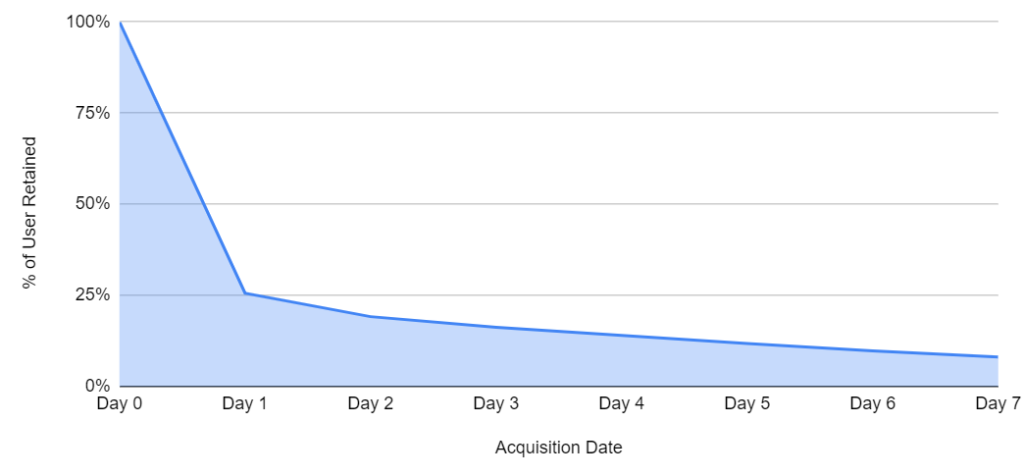
This retention curve clearly reflects the most important insight – around 75% of the users stop using the website after the first day. We can see a downfall in the engagement. Hence, it’s evident to improve the overall experience and abet customers through daily offers/coupons to boosting retention.
Cohort Analysis Comparison - Organic vs Direct
The below cohort analysis indicates that organic traffic has a better retention rate than direct.
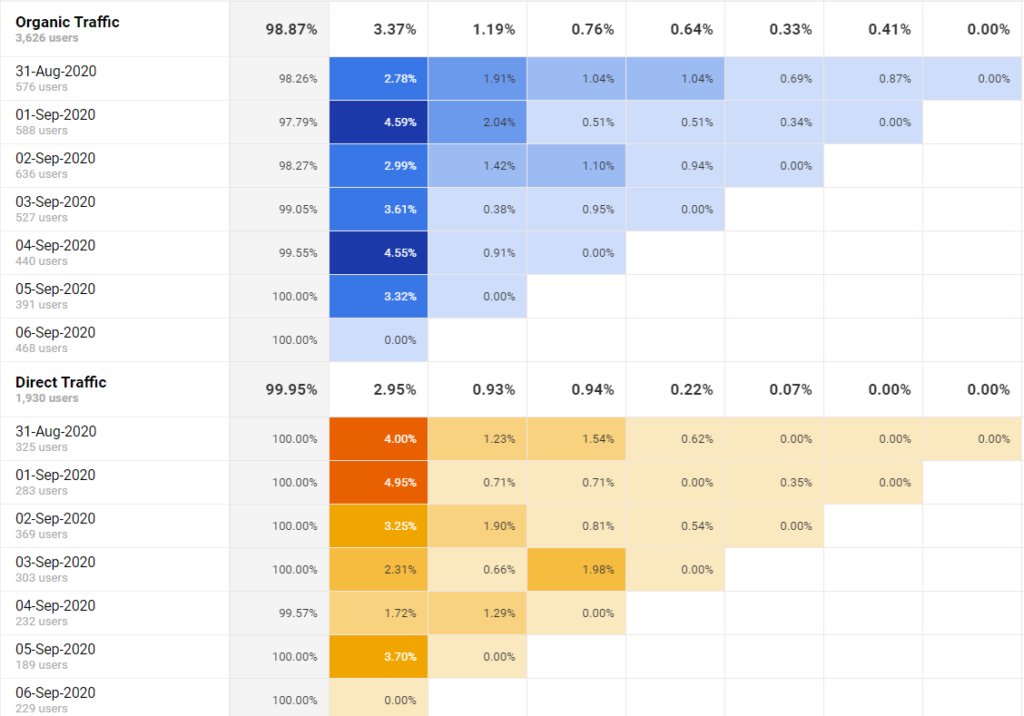
Visitor behavior analysis and its importance
It’s a process of tracking user behavior on a website and there are some great tools in the market that give accurate information. Tools like Hotjar, MouseFlow, Crazy Egg record visitor sessions to see how visitors are navigating on the website. They also offer click tracking and heatmaps to analyze the most engaging and ignored (skipped) elements on a page.
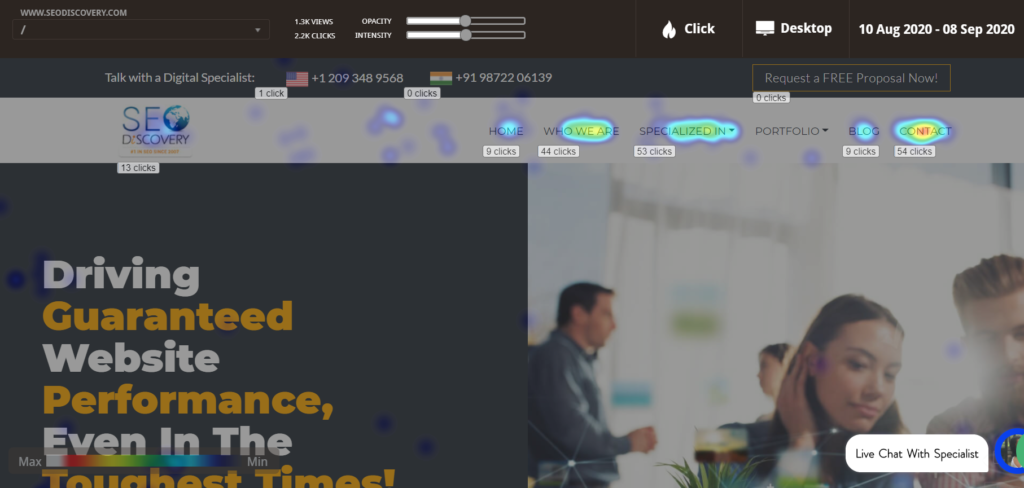
If you look at the above heatmap, you would notice that no one bothered to click on “PORTFOLIO” in the top menu, which means people aren’t interested in see the portfolio. Maybe we have to replace it with something more interesting (like Case Studies, Achievements, and more) which grabs a visitor’s attention. These kinds of insights help you add/remove elements to improve page engagement.
Using filters, you can further segment your audience to dig deep and pull out actionable insights, see those filter below:
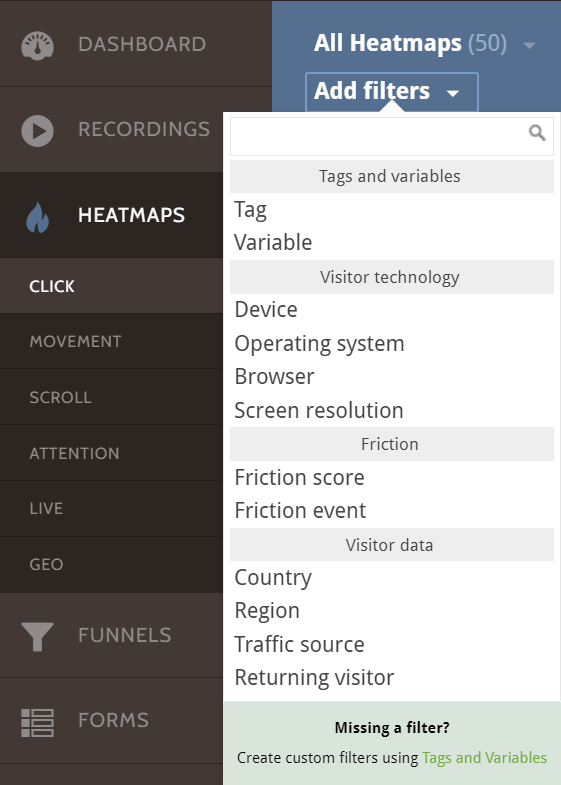
In Google Analytics, behavior flow gives you a visual presentation of how people are navigating on your website. You can apply segments to get a deeper view of their behavior and it also enables you to apply different dimensions on top of these segments to get actionable insights.
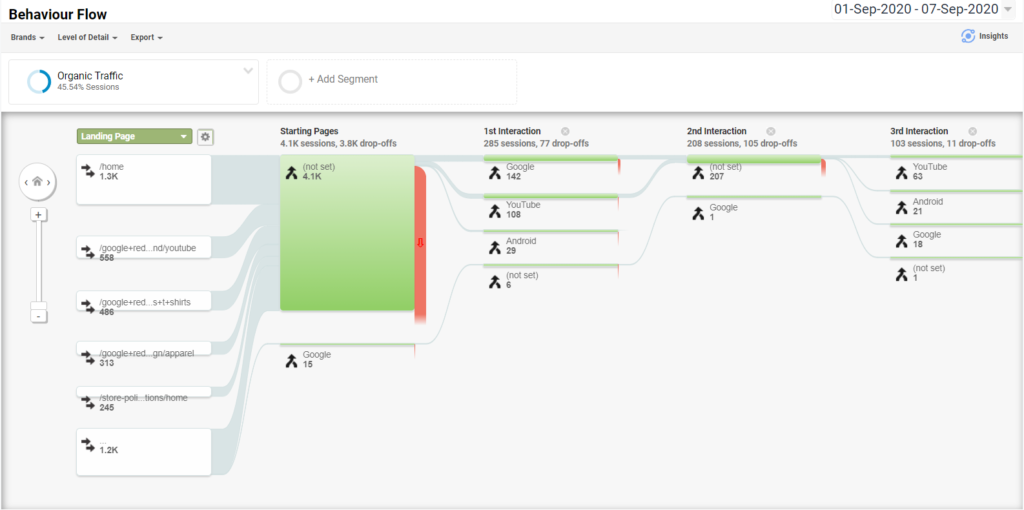
The power of these analytical tools lies in the fact that it allows you to view which customers leave and what’s making them leave your website/app – so that you can fix it. You can also hire a professional digital marketing agency that can help you find these hurdles and remove them to enhance your overall engagement.
Mandeep Singh is the MD of SEO Discovery. He’s mission is to provide affordable digital marketing services to startups and SMEs. He’s an official member of Forbes Agency Council. You can find him on LinkedIn.
The post Why behavior analysis is important online business appeared first on Search Engine Watch.
-
 Business2 months ago
Business2 months agoBernice King, Ava DuVernay reflect on the legacy of John Lewis
-
World News2 months ago
Heavy rain threatens flood-weary Japan, Korean Peninsula
-
 Technology2 months ago
Technology2 months agoEverything New On Netflix This Weekend: July 25, 2020
-
Finance4 months ago
Will Equal Weighted Index Funds Outperform Their Benchmark Indexes?
-
Marketing Strategies9 months ago
Top 20 Workers’ Compensation Law Blogs & Websites To Follow in 2020
-
 World News8 months ago
World News8 months agoThe West Blames the Wuhan Coronavirus on China’s Love of Eating Wild Animals. The Truth Is More Complex
-
Economy11 months ago
Newsletter: Jobs, Consumers and Wages
-
 Finance10 months ago
Finance10 months ago$95 Grocery Budget + Weekly Menu Plan for 8

